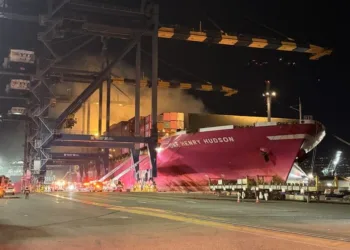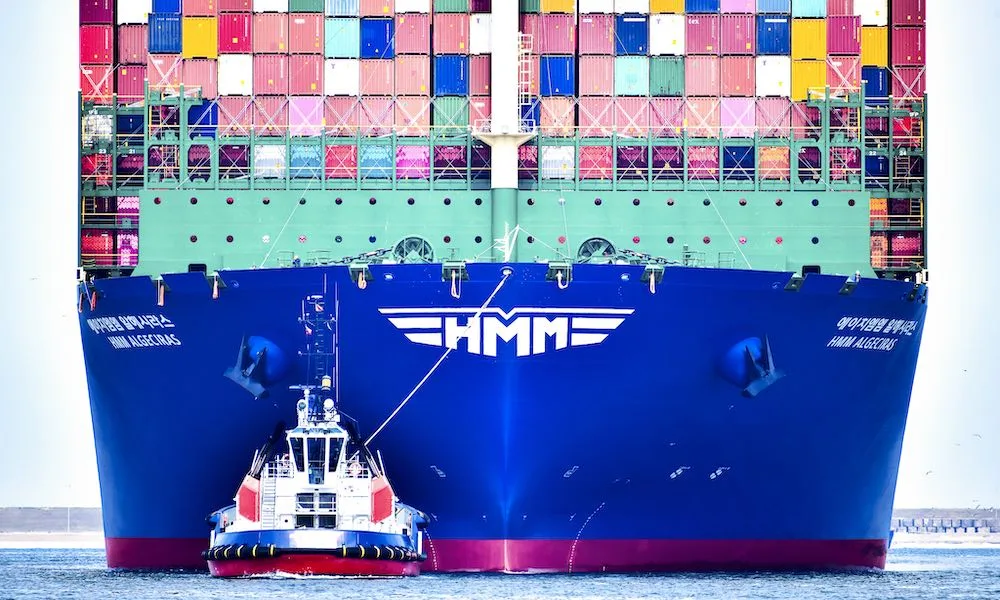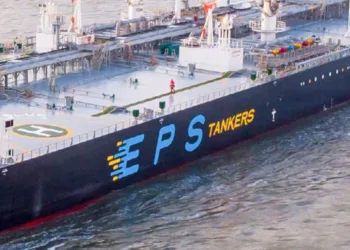NEW YORK — Just days away from the formal filing of Union Pacific’s application with regulators for its proposed merger with Norfolk Southern, the markets are starting to wake up to the deal’s potential to reshape how North America ships freight.
Share prices improved as UP Chief Executive Jim Vena told an industry conference that the time has come to create the first freight-only, coast-to-coast U.S. railroad.
“There’s no way that the United States of America should be the one country in North America that does not have a railroad that goes from one end to the other seamlessly,” Vena said while accepting an industry award at the RailTrends conference on Friday.
Vena warned that the merger also makes a business case to enable railroads to compete with a trucking industry that is rapidly deploying autonomous vehicles.
“The impact to the railroads are we need to move ahead or we’re going to get left behind,” he said. “That’s key.”
Vena said the negativity surrounding the merger reminded him of when railroads eliminated the caboose, and with it some train crew.
“If we would have listened to the naysayers, we’d still be running around with the caboose and four people on the frickin’ trains, and I bet you half of our business would be gone because we couldn’t compete against the world today. We’re efficient and we need to move ahead.”
Vena said competing railroads are criticizing the merger out of fear.
“The reason they’re complaining, they’re afraid, and they see the benefit of what a combined merged railroad can do in the marketplace. We can deliver better service, we can deliver better price. The customers are not going to have to carry as much inventory, as many assets, to be able to move their product across the United States of America. They’re going to see a benefit, if it’s a tank car coming out of Texas going east and we take 15%-20% off of that timeline times fewer tank cars times less inventory time the amount of winning in the marketplace, so that’s why they’re doing it.”
On the sidelines of the conference, Vena told me that he will go through every page of the merger application, adding the filing with the Surface Transportation Board would likely take place in the latter part of the first week of December.
The consolidation has attracted mixed reactions from an array of stakeholders ranging from shippers and competing railroads to attorney generals from a dozen states. Vena early on won President Donald Trump’s backing for the merger and secured approval from three of UP’s unions in exchange for job guarantees. Nevertheless, the company (NYSE: UNP) has budgeted $750 million to cover concessions in the merger process.
Despite its historic nature, the merger had mostly failed to spur sustained rallies of either company’s stock since it was announced in July. The transportation sector for the most part hasn’t drafted on the massive investment in AI, and there has been skepticism over what analysts think are overly optimistic forecasts by UP for post-merger growth amid longterm flat trends for rail freight.
That was until Friday, when Vena’s remarks helped push up UP’s stock price more than $4 per share; NS was up better than $6.
“It’s just the whole unknowing with the merger,” Vena said in response to a question from FreightWaves about investor indifference — first glancing at his smartwatch and noting UP shares were up a dollar. “That’s the normal process you go through on every merger. For some reason, the buyer goes down and the other side goes up in value.”
The deal will be the first to test the STB’s more stringent merger rules adopted after a series of operational meltdowns following a flurry of railroad tie-ups in the Nineties. Those rules stipulate a merger must offer enhanced competition, among other criteria, and analysts have been split on whether that gives UP-NS a firstcomer’s advantage, or that the partners will be navigating a dark tunnel.
Said Vena, “Enhanced means better product, right? Better movement and for us, specifically, is to give more options to our customers, to drive more competition, which it has you can see,” referring to a raft of recent interline agreements among the other Class I railroads.
Vena took issue with a specific question about whether the consolidation of U.S. railroads from four to three would in fact offer shippers less of a choice if UP chose to close off some gateways, particularly through the critical transcontinental hub of Chicago.
“I’ve been real clear: To go to Chicago, we do it ourselves directly, right from most of the some of the places just like we do today. But if we’re crossing over to the eastern U.S., we said we would keep the gateways open, and it’s up to CSX (NASDAQ: CSX) or Canadian Pacific (NYSE: CP) or Burlington (NYSE: BRK-B), they have to decide how they’re pricing for the level of service [they provide], whether they can compete, and they can compete in a lot of different ways. They can compete on price, they could say, ‘Listen, we want you through the interchange at Memphis for CSX, and we’re going to offer the customer this price,’ and if they can win it, they win it. So, it’s not as simple just because we have end-to-end connections today.”
Later, in a presentation, Vena emphasized how the merger will take trucks off the road in Chicago that currently handle UP interchange to NS and other railroads with through steel-wheel service.
Vena said there will be locations where UP can interchange on a hand-to-hand basis, “but it’s coming from another railroad or we’re giving it to another road, so it’s purely competitive.”
FreightWaves asked about the merger’s effect on so-called captive shippers such as producers of soda ash used in glass manufacturing, foods, chemicals, mining, metallurgy, and pharmaceuticals, served by only one railroad and which have no economic alternative mode and are ‘captive’ to that railroad’s rates and terms.
Vena portrayed that as a competitive advantage.
“What we’ve built for them, this doesn’t change them,” he said. “We work hard to get them to be able to compete as a worldwide product. People miss this — if you think that you can do whatever you want with pricing on soda ash, you have competitors and right now, go ask them how they are they competing on the world stage. Union Pacific has the most efficient, fastest service to get that product to tidewater for them to compete in the world, otherwise, they don’t get the business and we don’t haul it. That’s why people need to be really understanding of what is the true competition. You’re not just dealing with us, you’re competing against somebody else who has the same product.
“And that’s the advantage and I say this for all the railroads — I know they’re coming out pretty strong against us but let me give them an accolade — we move a ton of freight more economically than any other [transportation] system in the world, more efficiently. That’s what drives innovation. So they understand that.”
Vena said that a soda ash producer wrote a letter in support of the merger. He did not identify the company, but UP counts industry leader WE Soda of Wyoming as a customer.
In his presentation, Vena also touted the safety enhancements that the merger will support.
“We’re going to remove touch points on cars, as soon as you remove touch points on cars, actually, it’s a safer railroad. You don’t have to pump them as often.
Unsurprisingly, Vena noted that the companies’ shareholders overwhelmingly approved the merger in recent votes.
“Some of the biggest shareholders and companies in the U.S. that offer ETFs [exchange-trade fund] or mutual funds plus everybody else from individuals to companies — 99.52% voted for it.”
That hurdle cleared, Vena is confident as the deal heads to the actual arbiter, the STB.
“It’s good for public interest. It’s good for our employees,” Vena said. “I’m pretty comfortable that we will get it done.”
RailTrends is presented by industry publication Progressive Railroading.
Subscribe to FreightWaves’ Rail e-newsletter and get the latest insights on rail freight right in your inbox.
Find more articles by Stuart Chirls here.
Related coverage:
Rail merger no guarantee of growth: Analysts
Weekly rail freight lower but still ahead of 2024 for year
Rail merger could raise prices, hurt US ability to compete, say GOP legislators
Red state AGs: Rail merger could threaten national security
The post Union Pacific CEO: America needs coast-to-coast railroad, now appeared first on FreightWaves.



















